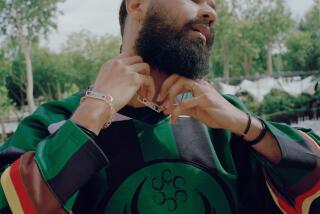Gianfranco Ferre, 62; designer had key role with Dior
Gianfranco Ferre, the Italian fashion designer known for his architectural creations and his tenure as stylistic director of the French firm Christian Dior, died Sunday in a Milan hospital. He was 62.
Ferre had a massive brain hemorrhage Friday and was taken to San Raffaele Hospital, where he died Sunday night, according to a statement from his family reported by the Associated Press.
Called “the Frank Lloyd Wright of Italian fashion” because of the strong influence of his architectural training on his fashion work, Ferre created structured and stylized clothes marked by simple geometric shapes, precise tailoring and clearly defined lines.
He used pearl grays, creamy beiges and rich browns in shades of cocoa, cognac and tobacco to form the foundation of his collections. He combined them with burnt orange, cyclamen pink and red.
“The design of a dress, furniture, a house, a room, a street and a city are all the same process,” he told a writer for Esquire magazine in 1988. “As an architect, I learned to think and express myself on flat forms, on paper, and to imagine the contour of the lines of a design.”
His creations were an immediate hit when they emerged in the late 1970s, and over the years his customers included some of the most beautiful and powerful women in the world, including Sophia Loren, Julia Roberts, Oprah Winfrey and Barbra Streisand.
Ferre said he tended to dress women who had “strong personalities.” He said his collections were meant for a woman “who looked at tradition but was making her own choice.”
He created a stir in the fashion industry in 1988, when he was named artistic director of the French fashion house Christian Dior, one of the first foreign-born designers to hold that position. Pierre Berge, the chairman of Yves Saint Laurent, expressed the view of the French design establishment when he observed: “I don’t think opening the doors to a foreigner -- and an Italian -- is respecting the spirit of creativity in France.”
A friend of Ferre’s, fashion designer Giorgio Armani, responded: “You’d think [the French] could find someone talented enough amongst themselves.”
Early on, it was clear that Ferre was having trouble merging his solidly built clothes with Dior’s emphasis on ultra-feminine shapes and frills.
In her critique of Ferre’s spring 1991 couture collection for Dior, Mary Rourke, then The Times fashion editor, noted, “In a few cases there appeared to be a meeting of the Dior and Ferre minds.... Otherwise, the search for clothes that blend the two talents continues.”
Ferre was born in Legnano, an upper-middle class suburb of Milan, on Aug. 15, 1944. Ferre’s father, an owner of a manufacturing company, died when he was a child. Raised by his mother and two aunts, Ferre acquired a taste for fine things and luxurious living that would serve him well later in life.
He studied architecture at Milan’s Polytechnic Institute and graduated in the late 1960s. He had trouble finding jobs and -- after a brief foray into interior design -- turned his hand to making jewelry.
His big break came in 1969, when Italian Vogue featured his creations in a fashion layout. Word of his talent spread and he was soon designing scarves and other accessories for top designers including Karl Lagerfeld.
In the mid-1970s, Ferre joined forces with Franco Mattioli, a Bolognese clothing manufacturer, and produced a collection of silk dresses for Mattioli’s Baila label.
Impressed by Ferre’s originality, Mattioli agreed to back the designer’s own label. With just $100,000 in capital investment, the two men started Gianfranco Ferre SpA, a holding company for his designs, in 1978.
Though his early lines were criticized by some as “hard to understand” and “stiff,” most critics praised them for being “extremely chic” and “smartly cerebral.”
Although his style remained consistent over the years, some fashion observers said the sense of stiffness gave way in the early 1980s to increasingly fluid shapes brought to life in seemingly weightless fabrics.
During the 1980s, he expanded his lines, debuting menswear, fragrances, watches, eyewear, bath accessories, furs and a haute couture collection.
Mattioli was credited with helping to transform the company into a multimillion-dollar enterprise, but Ferre also had a firm role on the business side.
“His projects are practical,” Rita Airaghi, Ferre’s cousin and longtime associate, told Vogue in a 1989 interview. “He goes to work with everything in his head -- market requirements, manufacturing schedules, financial limitations, development of themes, advertising.”
Ferre returned to Italy after leaving Dior in 1997. He opened two London stores and a new headquarters in Milan the next year.
In 2000, Ferre and Mattioli sold control of the company, and Ferre stayed on as creative director. His spring-summer 2008 menswear collection is to be presented in Milan next week.
He is survived by a brother.
Services are pending.






